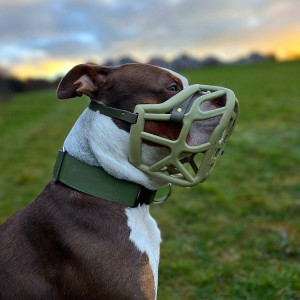The XL Bully Ban Is Here – What Happens Now For Your Dog?
From 1 February, XL Bullies must follow a strict set of rules and hold a certificate of exemption. Here’s what that means for your dog

share article
On 31 December, a new set of regulations regarding XL Bully dogsopens in a new tab came into effect in England and Wales making it an offenceopens in a new tab to sell, abandon, exchange, give away, breed or have an XL Bully in public without a lead and muzzle.
And now, as of 1 February, another regulation has come into effectopens in a new tab making it an offence to even own an XL Bully unless you have registered for a Certificate of Exemption. Without one, a dog parent faces a criminal record and fine, and the dog will be removed and potentially put down.
The rules were announced after the XL Bully – a larger and more muscular variant of the American Bully breed – joined the Pit Bull Terrier, Japanese Tosa, Dogo Argentino and Fila Brasileiro as a breed banned under the Dangerous Dogs Act 1991 in October.
It’s a move made by the government who sayopens in a new tab the legislation is needed to protect the public from tragic dog attacks following “a concerning rise in attacks and fatalities caused” by XL Bully dogs.
Additionally, from 30 June, all XL Bully dogs over one year old must be neutered, with an extension given for younger dogs until 31 December.
It is reported that 40,000 XL Bullies have been granted exemption certificatesopens in a new tab, however, there are concerns that the number of XL Bullies in the UK could be much higher. Despite the government offering compensation to dog parents opting to euthanise their dogs, only 117 compensation claims have been made.
Many charities and dog parents disagree with the new laws. However, it is so important that these new laws must be adhered to, otherwise, the parents run the risk of criminalisation and their dogs being seized and possibly destroyed.
Is my dog an XL Bully?
“An XL Bully, also known as an American Bully XL is the largest of the American bully type of dog,” says Becky Thwaites, of the national pet charity Blue Crossopens in a new tab. “It has been developed by crossing several breeds of large bull breed and other dogs. While it is not recognised as a breed in the UK, the Government has published an official definition for owners and enforcement officers.”
Even though the official definitions have been published, Rachel Fletcher, a partner in the crime team at Slater Heelis, solicitors in Manchester, has had lots of people ringing her office in recent months confused about whether their dog is in fact an XL Bully.
“The dog experts have been pointing out the difficulties with the official definition,” says Rachel.
If the dog’s height is 20 inches (for an adult male) or 19 inches (for an adult female) at the withers, and meets a ’substantial number’ of the characteristics listed by the government guidanceopens in a new tab, then a parent should have applied for the Certificate of Exemption and adhere to the rules that came out at the end of the year.
“But they haven’t said what substantial is,” says Rachel. “Is that four out of 10 of the characteristics? It’s not been defined. There’s no black and white. The only way to know for sure is to contact your local dog liaison officer or dog expert.”
Rachel said many dog parents have wisely gotten their Certificate of Exemption and are sticking to the rules if they even suspect their dog might be an XL Bully.
How will the new laws be policed?
Becky said that it is ultimately down to individual police forces and their dog legislation officers to enforce the new legislation, but Rachel suspects it will be members of the public who raise concerns.
“I imagine that council and local dog wardens will have loads of anonymous reports that they will then have to follow up. I think that is mainly how it will be policed,” says Rachel.
She also said that people will now be able to directly ring the police with reports, and indeed the National Police Chief’s Council (NPCC) have urged members of the public to call 101 to report those suspected of flouting the rules. NPCC dangerous dogs lead assistant chief constable Mark Hobrough said: “There’s an obligation on everybody within society to stop a serious or fatal dog attack happening within their own community.”
“Another way it might happen is that say you have one of these dogs and you haven’t got an exemption, and it gets injured, and you take it to the vets, they will report for sure,” adds Rachel.
What you should know if you are reported for breaking the laws
If you have a Certificate of Exemption, you are agreeing that you are over 16 years old and that you will ensure your XL Bully is microchipped, neutered, kept on a lead and muzzled in public, held in a secure place so it can’t escape, and covered by third-party liability insurance. You are also agreeing to not sell, advertise, abandon, exchange, give away or breed the dog.
“By getting the certificate, you have confirmed you will abide to all of those rules,” says Rachel.
If you are found not to be adhering to these rules, you can be reported to the police or council, and the police then have the right under the Dangerous Dogs Act to seize and destroy the dog unless there is a pending prosecution under Section 1 of the current Dangerous Dogs Act.
If you don’t have a certificate, and it gets found out, the outcome is the same – your dog could be seized and destroyed. Despite the reports claiming the police are short on kennels and may struggle to seize dogsopens in a new tab, it is still incredibly important to take the threat of seizure seriously.
In both cases, it is then up to the dog’s parent to prove the dog is not a banned type. The parent can hire a dog expert to prove this or hire a legal expert to get it proven on their behalf. “Nothing can happen to that animal until the prosecution has taken place,” says Rachel.
If a prosecution does follow, a legal expert will be needed to argue for the pet parent in court. If it is proven that the dog is not an XL Bully, the court must order the dog to be returned. If the parent or lawyer cannot prove it, or they plead guilty, they will be convicted of a crime, fined, and possibly sent to prison. The dog will also be destroyed.
How can I keep myself and my dog safe?
The best way to make sure your XL Bully stays safe is to adhere to all the new laws – not to take any risks. “Make sure you know and follow the rules,” says Rachel.
If for some reason you didn’t apply for an exemption by noon on 31 January, your dog is now at risk. “The only way of then getting them exempted would be through the courts and we do not know what that this process will look like, but it will be more thorough than the current self-exemptions scheme,” says Rachel. “The courts would look at the owner as well as the dog and the requirements will be more stringent (same way as Pit Bulls now).”
If this applies to you, your best bet is to contact legal assistance and work out the next steps with them. If you are worried about the costs of legal help, speak to the Citizen’s Advice Bureauopens in a new tab who may be able to help you find free or low-cost assistance.
What if I live in Scotland?
The Scottish Government has announced its adoption of the UK’s XL Bully ban, aligning its legislation with that in England and Wales. While the ban will be nearly the same in Scotland, the timeline for implementation has yet to be announced.
“Owners in Scotland are advised to examine the new regulations outlined in England and Wales and prepare accordingly,” Ellidh Clark from Complete Clarity Solicitors and Simplicity Legal told The Wildest. “As it is expected that identical safeguards will soon be implemented in Scotland.”

Lauren Crosby Medlicott
Lauren is a freelance journalist who lives with her family and black labrador, Betsie, in the south Wales valleys. When she's not working, she loves going for a dip in a nearby river and hiking in the Brecon Beacons.
Related articles
![Grey XL Bully looking up at camera]() opens in a new tab
opens in a new tabHow to Protect Your XL Bully Under the New Ban
How to keep your dog happy and healthy under the new legislation
![Photo Courtesy of @doug.thexlbully]() opens in a new tab
opens in a new tabHow to Muzzle Train Your Dog
Contrary to common belief, muzzles aren’t solely for aggressive dogs
![dog bouncing on lead in the countryside with girl]() opens in a new tab
opens in a new tabHow to Make On-Lead Dog Walks More Exciting
There are plenty of ways to spice them up
![Great Dane puppy and Husky meeting on leash out side.]() opens in a new tab
opens in a new tabUnderstanding Reactivity and Aggression in Dogs: Two Very Different Things
Apparently even experts have a hard time defining these terms
![corgi puppy hiding under table afraid]() opens in a new tab
opens in a new tabDog-on-Dog Attacks: How To Help Your Dog Recover Their Confidence
The emotional road to recovery can be a long one. Here’s what you can do




